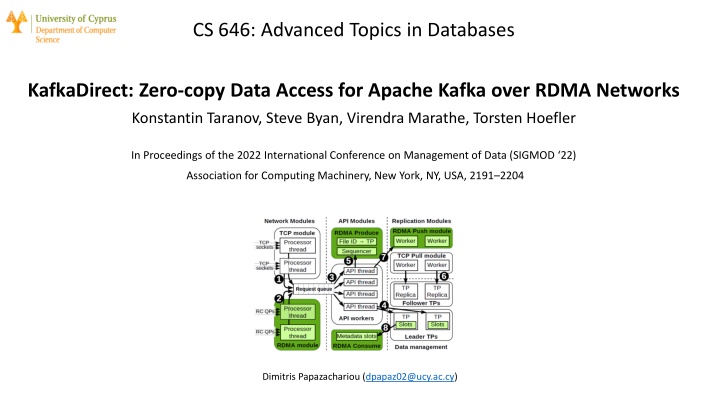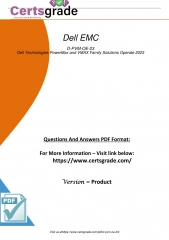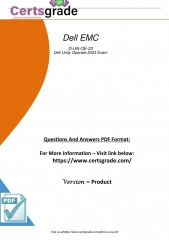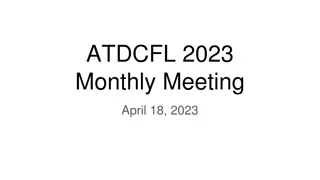
Zero-copy Data Access for Apache Kafka over RDMA Networks
Explore the innovative technology of Remote Direct Memory Access (RDMA) and its application in improving performance and efficiency in distributed systems like Apache Kafka. RDMA enables direct memory exchange between networked computers, bypassing traditional processing layers for enhanced throughput and reduced latency.
Download Presentation

Please find below an Image/Link to download the presentation.
The content on the website is provided AS IS for your information and personal use only. It may not be sold, licensed, or shared on other websites without obtaining consent from the author. If you encounter any issues during the download, it is possible that the publisher has removed the file from their server.
You are allowed to download the files provided on this website for personal or commercial use, subject to the condition that they are used lawfully. All files are the property of their respective owners.
The content on the website is provided AS IS for your information and personal use only. It may not be sold, licensed, or shared on other websites without obtaining consent from the author.
E N D
Presentation Transcript
CS 646: Advanced Topics in Databases KafkaDirect: Zero-copy Data Access for Apache Kafka over RDMA Networks Konstantin Taranov, Steve Byan, Virendra Marathe, Torsten Hoefler In Proceedings of the 2022 International Conference on Management of Data (SIGMOD 22) Association for Computing Machinery, New York, NY, USA, 2191 2204 Dimitris Papazachariou (dpapaz02@ucy.ac.cy)
Outline Remote Direct Memory Access (RDMA) Publish-Subscribe messaging systems Apache Kafka KafkaDirect Evaluation Discussion
Outline Remote Direct Memory Access (RDMA)
Remote Direct Memory Access (RDMA) Remote Direct Memory Access is a technology that enables two networked computers to exchange data in main memory without relying on the processor, cache or operating system of either computer. RDMA improves throughput and performance because it frees up resources, resulting in faster data transfer rates and lower latency between RDMA-enabled systems. [https://www.techtarget.com/searchstorage/definition/Remote-Direct-Memory-Access]
RDMA https://www.techtarget.com/searchstorage/definition/Remote-Direct-Memory-Access
RDMA Improve performance of: query processing distributed index structures and transactions data replication Naive use of RDMA not achieve maximum performance
RDMA https://core.vmware.com/resource/basics-remote-direct-memory-access-rdma-vsphere
Network protocols supporting RDMA 1.Infiniband 2.RoCE (RDMA over Converged Ethernet) 3.iWARP
Network protocols supporting RDMA https://support.huawei.com/enterprise/en/doc/EDOC1100203339
Network protocols supporting RDMA https://support.huawei.com/enterprise/en/doc/EDOC1100203339
Products and vendors supporting RDMA Apache Hadoop and Apache Spark FreeBSD operating system Microsoft Windows Server (2012 and higher) Nvidia DGX deep learning systems Oracle Solaris and NFS over RDMA Red Hat Enterprise Linux TensorFlow open-source software library for machine intelligence VMware ESXi https://www.techtarget.com/searchstorage/definition/Remote-Direct-Memory-Access
Outline Publish-Subscribe messaging systems
Publish-Subscribe messaging systems Asynchronous data transfer between applications https://cloud.google.com/solutions/event-driven-architecture-pubsub
Publish-Subscribe messaging systems Building block for data center applications Applications as open-source systems (Apache Kafka) and as a service Sequence of ordered records in append-only data logs
Outline Apache Kafka
Apache Kafka Fault-tolerant distributed publish-subscribe messaging system https://www.projectpro.io/article/apache-kafka-architecture-/442
Kafka Topics Records categorized into topics partitioned into partitions (topic partitions) TP ordered, immutable sequence of records Sequential ID numbers (Kafka offset)
Kafka Topics Distinct files on disk New record appended to the head segment Record size: 1 MB Segment size: 1 GB Replicated TP (replication leader, replication followers)
Kafka Broker Broker: storage server of Kafka cluster Receives records from producers Assigns offsets Commits records to local disks Responds to fetch requests Processes multiple TPs
Outline KafkaDirect
KafkaDirect Extension to Apache Kafka RDMA to accelerate record production, consumption and replication Focus on InfiniBand standard and reliably connected queue pair (RC QP) Consumers directly read records from subscribed topics (bypass CPU of brokers)
KafkaDirect RDMA network module RC QP connections from clients and brokers RDMA Produce module producers write data directly to TP files RDMA Push module replicate data directly from leaders to followers RDMA Consume module metadata slots (information about TP files)
RDMA produce datapath RDMA Produce module generates a unique ID, sends it to producer API worker thread maps the file ID to the requested TP Broker commits records
RDMA push replication Leader writes new records to TPs of its followers Disadvantage replication gets triggered for each new record KafkaDirect batches contiguous RDMA Writes into a single Write Maximum batch size: 1 KB
RDMA consume datapath Main goal: offload the processing of fetch requests to RNICs RDMA consumer periodically reads metadata slots of subscribed TPs (to get informed whether new records have been appended to them) For each RDMA consumer brokers allocate a region (stores metadata slots) Fetch size: 2 KB
Outline Evaluation
Evaluation Comparison of the performance of KafkaDirect with: 1. the original Apache Kafka 2.2.1 (Kafka) 2. an RDMA-enabled Kafka proposed by the Ohio State University (OSU Kafka) KafkaDirect outperforms the existing Kafka systems (in terms of bandwidth and latency for all datapaths)
Evaluation KafkaDirect uses RDMA to accelerate the three most network intensive datapaths. The RDMA producer offers a 9x improvement over today s Kafka producer bandwidth. The RDMA replication module provides a 13x improvement in replication performance. The RDMA consumer offers a 50x reduction in latency and a 10x increase in throughput.
Outline Discussion
Discussion Memory usage KafkaDirect has higher memory usage compared to Kafka Batching requests targeting different TPs KafkaDirect s RDMA datapaths cannot batch RDMA requests that target different TP files Reliability of RDMA KafkaDirect uses reliable RDMA connections Security of RDMA InfiniBand architecture (not secure transport, not possible application-level encryption) Proposal for secure RDMA transport sRDMA















